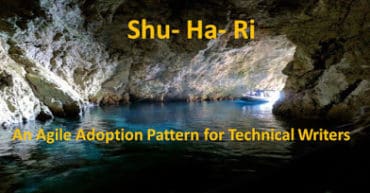guest words
Agile technical writer Agilism can be described as a concept, a doctrine, a philosophy, based on tenets of Agile Manifesto and Agile principles, as applied to Software Product Development. It is interesting to share that Agile principle when applied to any product development process, enhance the rate of product delivery in general, with simple, working prototypes produced early in the project lifecycle. Early prototypes ensure customer satisfaction and encourage them to actively participate in shaping the product according to need and required functionality. It provides with the opportunity to give directions, create changes according to need and ultimately, help the team to develop a product with value and maximum Return on Investment (ROI). Customer feedback helps the team to iterate, re-iterate the product in a continuous manner and help in fast, simple, and better product delivery. Cross-functional and self-organizing teams work best in this environment. Agile principles can be applied similarly to documentation product delivery, as well. Effective agile documentation is a balancing act, for an Agile document developer. The goal is to write just enough documentation, just in time and just for the right audience. Application of Agile, to product documentation in general, while working on an Agile project enabled me, to align my documentation, with the developing software product. I worked with a truly Agile team, who were fast enough in product delivery, after each iteration. My journey from a Technical Writer to an Agile Technical Writer was really hard and exciting. To catch-up with such a team and simultaneously document the features of working financial product, it was necessary to know their working styles. Application of Shu Ha Ri model – the Japanese Martial art concept of training and learning, came handy to me in Agile documentation journey. Therefore, I began to learn the basics. Enrolled myself in Agile awareness and training program in the organisation and thus started my Agile journey. This model describes stages of learning from beginner to level of mastery, this concept helped me, in learning Agile principles and gaining the skills, required to create, agile documentation and later apply the same principles to my documentation style. According to this age-old Japanese Martial Art concept: Shu– Learn and then perform actions to become the showstopper and role model, for others to follow. Ha– Innovate new styles of product deliveries, improvise, and apply Agile rules. Ri– Transcend finally with your unique style to a different level and establish your own niche. Agility is part of my daily routine now. I find myself somewhere between Shu – Ha stages where I have learned the principles of agility, and strictly and honestly following them in my style of agile documentation, with spikes, as and when required. This enabled me to gain customer confidence and produce faster, simpler, and better documentation with maximum Return on Investment (ROI) value! Following Shu Ha Ri model may also help and envision the newcomers and future aspirants of technical writing field, in gradually setting up the stage for, creating an agile mindset and equally agile working environment. Technical communication community, practitioners, as well as the young aspirants, may gear up, learn and apply the Agile methodologies in their Technical Communication during project and product documentation. They can be encouraged to learn the need of continuous iteration, through feedback and fast document delivery, according to customer requirements. Produce incremental quality documents, with minimum or no defects. This will enable them to write just enough and just required, precise documents, which are light, simple, and easy to refactor. Technical Writers and aspiring writers will get to know the nuances of writing in Agile which they would like to remember, innovate on their own, improvise, and apply to their styles of writing. They can learn to be on edge all the time, catch-up fast with changing the environment, reap the benefits of learning new tools and technologies fast, to mold themselves with emerging technologies, and adjust to the changing requirements frequently. All this could be achieved by being agile enough to pick up new techniques and methodologies and leverage them to enjoy maximum benefit. Shu Ha Ri model can enhance the quest for learning Agile methodologies, create a mindset for faster and simpler documentation and improvise further for the advantage of a technical writing community. This model urges the followers, to take a plunge in the lake of agility, hone the skill and gradually apply it to their document deliveries, while adding a dash of technology and creativity, increase expertise to an extent where they become the trailblazers, on the path of documentation. Such an environment and mindset can be created by self-motivated individuals, who really want to make difference in smoother, faster product delivery and contribute in agile transformation. They should follow Agilism, follow tenets of Agile methodologies while learning through Shu- Ha- Ri model and walk through the path of Agile learning and gain mastery in Agile documentation! If you want to learn and understand the principals of agility in documentation join Information Developers Foundation Certified Agile Technical Communication. Author Biography Shikha Saxena Shikha Saxena is a Senior Technical Writer in HSBC Technology, Pune, India. She is actively involved in learning and applying Agile methodologies in product and business architectural documentation in financial domain. She is an active blogger on organizational intranet. Managed web content writing, editing, and publication of the same.She was a lecturer, teacher, researcher, and mentor to Science (Biochemistry) and Engineering (Biotechnology) Graduates and Post Graduates of Uttar Pradesh Technical University (UPTU), in NCR, New Delhi, India, before her global career as a Software Engineer/Technical Writer (2009). She envisions the community in multiple ways and contributes towards making society, vibrating and lively place!
In an initiative to encourage ADID Alumni and other technical writers to share technical writing knowledge, ADID invited Neha Srivastava to share her understanding on the documentation development life cycle and she comes up with well-knit and researched post. You can write to her or post a comment to ask anything dropping from your mind on DDLC. Introduction to Document Development Life Cycle The Document Development Life Cycle (DDLC) is the process of developing documents. It is necessary to follow DDLC to enhance the quality and optimize timely delivery of the document. The Document Development Life Cycle is mainly comprised of steps which are given below, it can vary company or project-wise also: Requirement Analysis Designing Developing the Content Editing/ Proofreading Publishing Maintenance Requirement Analysis During the Requirement Analysis process we gather the information of the product from SMEs, available documents, online search etc. We analyze the criteria of producing the product according to the audience. In Audience analysis, we analyze who will use this product, what is the need of creating the product, and measures of skill and expertise of the audience etc. We also figure out what tools we are going to use like RoboHelp, Framemaker etc. By understanding the product requirement, we can easily estimate the time, resources and cost of the product. Designing In Designing phase, we design the document we create templates, master page etc.We take approval of design like fonts size and style, list, table, numbering and look and feel approval is taken from concern person. Developing the Content We develop the content according to the product features and requirement. We analyze the product, run the product and write the draft according to the product. We create user manual, user guide, reports, and online help etc. We add a title, copyright, content, index, glossary, and appendix etc in the manual.This is actual content development phase. Editing/ Proofreading Editing is the process in which we test the creating project according to the requirement, and product features. We check the first draft through Technical Writer-editor, peer review or the technical review etc. In this phase, we check the technical part, grammar mistakes, figures, and format etc. Proofreading is the final testing of the project by checking proper layout, style and grammar mistakes etc. In this phase, we check the draft entirely. Our main purpose is to remove the bug from the draft, so that document is clear and understandable.To read more on proofreading click here. Publishing In this phase, we publish the document as online help, and print document etc. Print documents are the hard copy in which all the content may be in long sentences or paragraph, and screenshots. In online help, we add hyperlinks, and content is in short sentences. These documents are useful to end users to determine the exact use of the product. Maintenance Maintenance is the process in which we add updates, create versions after modification in the project. When a new product comes into the market, the user manual is updated according to the added new feature. Companies also spend cost in creating Support Centers for enhancing user satisfaction.
Sasmita Panda wrote this guest post.She is a seasoned Information Developer, Content writer, and blogger. I invited her to share her experience on the primary skills required by information developers and she come up with a well knit blog for you. Read more blogs of Sasmita on TWIN What are the qualities of a good technical writer? Mastering over the language or strong technical skills? The debate is constantly on. As per my experience, language is important, but it’s your acumen in technical skills which will take you higher in the long run. Strong writing skills along with deeper technical knowledge are always considered as added advantage. Understanding a product/application and documenting about it is what every technical writer does, but knowing about how to structure and present the information to various types of end-users is definitely a valuable skill. There are technical writers who are good in writing skills but poor in technical skills and vice verse. You can always work on the skills you lack, but I believe that honing technical skills takes longer time as compared to the writing skills. You don’t have to stupendous in your writing skills to be a good technical writer, but expertise in technical skills is a must especially if you want to grow in your career as a technical writer. Proficiency in technical skills has a growing demand in many industries these days. Knowledge of DITA, API Documentation or software programming can fetch you a better package than many of your experienced peers. So if you want to grow and make money as a technical writer, the choice is obvious- sharpen your technical skills. Related PostTwitter Vs FacebookBefore you foray into technical writingAfter you foray into technical writingJobsWhy Should you love book Please take out few minutes to write your view on Language Vs Technical Skills.



